Chemistry polyatomic ions Guías de estudio, Notas de estudios & Resúmenes
¿Buscas las mejores guías de estudio, notas de estudio y resúmenes para Chemistry polyatomic ions? En esta página encontrarás 153 documentos de estudio para Chemistry polyatomic ions.
Página 3 fuera de 153 resultados
Ordenador por
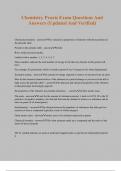
-
Chemistry Praxis Exam Questions And Answers (Updated And Verified)
- Examen • 7 páginas • 2024
-
- $11.49
- + aprende más y mejor
Chemistry Praxis Exam Questions And Answers (Updated And Verified) Chemical periodicity - answerThe variation in properties of elements with their positions in the periodic table Periods in the periodic table - answerPeriods: Rows which run horizontally. Labeled with a number: 1, 2, 3, 4, 5, 6, 7. These numbers indicate the total number of energy levels that any element in this period will have. For example, K (potassium) which is found in period 4, has 4 energy levels when diagrammed. ...

-
Chemistry 10th Edition International Edition by Kenneth W - Test Bank.
- Examen • 973 páginas • 2023
-
Disponible en paquete
-
- $33.39
- + aprende más y mejor
Chapter 1—The Foundations of Chemistry MULTIPLE CHOICE 1. Which of the following statements is incorrect? a. A body in motion possesses kinetic energy because of its motion. b. An object possesses potential energy because of its position or composition. c. Nuclear energy is an important kind of potential energy. d. Chemical reactions and physical changes that release energy to their surroundings are endothermic. e. The Law of Conservation of Matter and Energy states that the combined ...
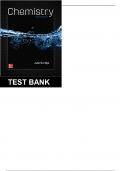
-
Test Bank For Chemistry 4th Edition By Burdge
- Examen • 809 páginas • 2023
-
- $32.08
- + aprende más y mejor
Chapter 02 Atoms and the Periodic Table 1. The scientist who determined the magnitude of the electric charge on the electron was A. John Dalton. B. Robert Millikan. C. J. J. Thomson. D. Henry Moseley. E. J. Burdge. Blooms: 1. Remember Difficulty: Easy Gradable: automatic Subtopic: Structure of the Atom Topic: Components of Matter 2. When J. J. Thomson discovered the electron, what physical property of the electron did he measure? A. its charge, e B. its charge-to-mass ratio,...
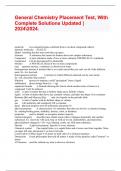
-
General Chemistry Placement Test, With Complete Solutions Updated | 20242024.
- Examen • 8 páginas • 2024
- Disponible en paquete
-
- $12.89
- + aprende más y mejor
General Chemistry Placement Test, With Complete Solutions Updated | 20242024. molecule two nonmetal atoms combined form a covalent compound called a diatomic molecules H2,O2,F2 Matter Anything that has mass and takes up space Element A substance that cannot be broken down into simpler substances Compound A pure substance made of two or more elements CHEMICALLY combined. Compound Can be decomposed by chemically Mixture A PHYSICAL blend of two or more components (aq) aqueous mi...
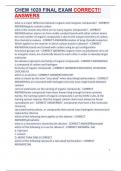
-
CHEM 1020 FINAL EXAM CORRECT!! ANSWERS POSSIBLE TESTED QUESTIONS(what is a major difference between organic and inorganic compounds......)
- Examen • 11 páginas • 2023
-
- $7.99
- + aprende más y mejor
CHEM 1020 FINAL EXAM| 184 QUESTIONS| WITH COMPLETE SOLUTIONS what is a major difference between organic and inorganic compounds? - CORRECT ANSWERorganic contain carbon what is the reason why there are so many organic compounds? - CORRECT ANSWERcarbon atoms can form stable covalent bonds with other carbon atoms the vast number of organic compounds is due to the unique chemistry of carbon. this chemistry involves - CORRECT ANSWERformation of long chains& isomerism Which applies to the manner in w...
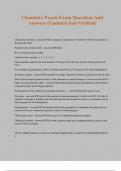
-
Chemistry Praxis Exam Questions And Answers (Updated And Verified)
- Examen • 7 páginas • 2024
-
- $11.49
- + aprende más y mejor
Chemistry Praxis Exam Questions And Answers (Updated And Verified) Chemical periodicity - answerThe variation in properties of elements with their positions in the periodic table Periods in the periodic table - answerPeriods: Rows which run horizontally. Labeled with a number: 1, 2, 3, 4, 5, 6, 7. These numbers indicate the total number of energy levels that any element in this period will have. For example, K (potassium) which is found in period 4, has 4 energy levels when diagrammed. ...
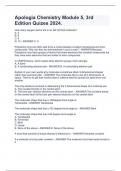
-
Apologia Chemistry Module 5, 3rd Edition Quizes 2024.
- Examen • 2 páginas • 2024
-
Disponible en paquete
-
- $9.99
- + aprende más y mejor
Apologia Chemistry Module 5, 3rd Edition Quizes 2024.How many oxygen atoms are in an Al2 (CO3)3 molecule? A. 3 B. 6 C. 9 D. 12 - ANSWER C. 9 Polyatomic ions are often said to be a cross between covalent compounds and ionic compounds. Why can they be characterized in such a way? - ANSWER Because Polyatomic ions have groups of atoms that share electrons like covalent compounds but they have extra electrons that are similar to ionic compounds. In VESPR theory, which repels other electr...
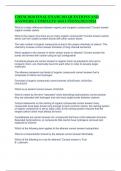
-
CHEM 1020 FINAL EXAM| 184 QUESTIONS AND ANSWERS| COMPLETE SOLUTIONS|2023/2024
- Examen • 12 páginas • 2023
-
Disponible en paquete
-
- $14.28
- + aprende más y mejor
CHEM 1020 FINAL EXAM| 184 QUESTIONS AND ANSWERS| COMPLETE SOLUTIONS|2023/2024 What is a major difference between organic and inorganic compounds? Correct answer organic contain carbon What is the reason why there are so many organic compounds? Correct answer carbon atoms can form stable covalent bonds with other carbon atoms The vast number of organic compounds is due to the unique chemistry of carbon. This chemistry involves correct answer formation of long chains& isomerism Which a...
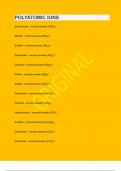
-
POLYATOMIC IONS|UPDATED&VERIFIED|100% SOLVED|GUARANTEED SUCCESS
- Examen • 2 páginas • 2023
-
Disponible en paquete
-
- $12.49
- + aprende más y mejor
Study POLYATOMIC IONS Share In-class activity Classic Live Checkpoint Self-study activity Flashcards Learn Test Match perchlorate (ClO₄)⁻ 1 / 23 Profile Picture Created by Badman892 Teacher Biggs AP Chemistry Terms in this set (23) Original
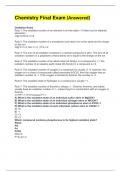
-
Chemistry Final Exam (Answered)
- Examen • 34 páginas • 2023
-
- $14.49
- + aprende más y mejor
Chemistry Final Exam (Answered) Oxidation Rules Rule 1: The oxidation number of an element in its free state = 0 (Also true for diatomic elements) -Mg=0,H2=0, C=0 Rule 2: The oxidation number of a monatomic (one-atom) ion is the same as the charge on the ion -Mg^2+=+2, Na^+=+1, O^2-=-2 Rule 3: The sum of all oxidation numbers in a neutral compound is zero. The sum of all oxidation numbers in a polyatomic (many-atom) ion is equal to the charge on the ion. Rule 4: The oxidation numb...

5,99 euros por el resumen de tu libro de texto multiplicado por 100 compañeros... Haz cuentas: ¡eso es mucho dinero! No seas ladrón de tu propia cartera y empieza ya a subir el tuyo. Descubre todo sobre cómo ganar en Stuvia


